Wouldn’t it be great if there was a single location in your customer relationship management (CRM) solution where you could track all of your communications with customers across all of your different channels? Well, if you’re a HubSpot user, there is! It’s called the HubSpot inbox (or the conversations inbox), and it can be crucial for driving engagement with your top leads.
What is the HubSpot inbox? How does it work? Most importantly, how can you use it to meet your marketing goals? Read on to learn more about this marketing and sales tool in your HubSpot portal!
Don't have time to read the whole article? Reach out to the BZ team for help with your HubSpot Conversations tool today!
What Is the HubSpot Inbox Tool?
As stated by HubSpot: “The conversations inbox is a central location in your HubSpot account where messages from all of your connected channels will appear. You can view ongoing conversations, reply to messages, and create tickets to track customers’ issues.”
In other words, it’s your place to centralize your communications across your team/company email inboxes, chat widgets, forms, and social media conversations—hence the alternate name of “HubSpot conversations inbox.”
In this tool, you can—depending on your HubSpot subscription and permissions within your portal—edit the default conversations inbox in your portal or create a series of custom inboxes to suit your specific needs.
What Are the Business Benefits of Using the HubSpot Conversations Inbox?
So, what are the benefits of having a centralized location to organize your conversations across different communication channels? After all, couldn’t you also track interactions with specific prospects and customers in their individual contact profiles?
You could go to individual contacts in the contacts database to review their actions and your communications with them, but this isn’t really scalable when you’re dealing with dozens, or even hundreds, of potential leads or current customers.
With the conversations inbox tool, your recent interactions with customers can be sorted through to more easily find currently active leads so you can prioritize them more easily.
Dare to compare—here’s a quick screenshot of what the contacts database looks like:
 Here’s a screenshot of the conversations tool:
Here’s a screenshot of the conversations tool:
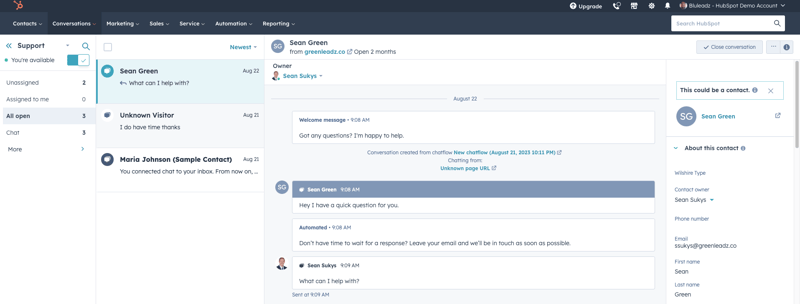
In the database, you’d have to search for the specific contact you want to interact with, click through to their contact profile, and then look at their recent activity. This is useful for getting to see all of a contact’s interactions with your brand. However, it’s not as easy to move between different contacts to see which ones have been followed up on.
Meanwhile, the conversations inbox makes it easier to quickly switch between recent interactions so you can keep up with hot leads. You can also filter by conversations assigned to you, all open conversations, channel-specific conversations, and other factors.
This makes it easier to keep up with conversations in real-time so you can follow up with prospects and customers immediately with your manual communications. This helps increase your responsiveness, which can provide benefits like:
- Keeping your brand top of mind.
- Improving customer experience throughout the buyer’s journey.
- Increasing conversions by leveraging opportunities as soon as they arise.
Instead of having to manually go into individual contact profiles to see if they’ve responded to your Facebook Messenger or live chat messages, you can save time by using the conversations inbox.
What Are the Key Features of HubSpot Inbox?
So, what are the key features of the conversations inbox tool? Features include:
1: The Inbox Dropdown
If you have access to multiple conversation inboxes, you can click on the icon next to the name of your currently active inbox to get a dropdown list of all your available inboxes.
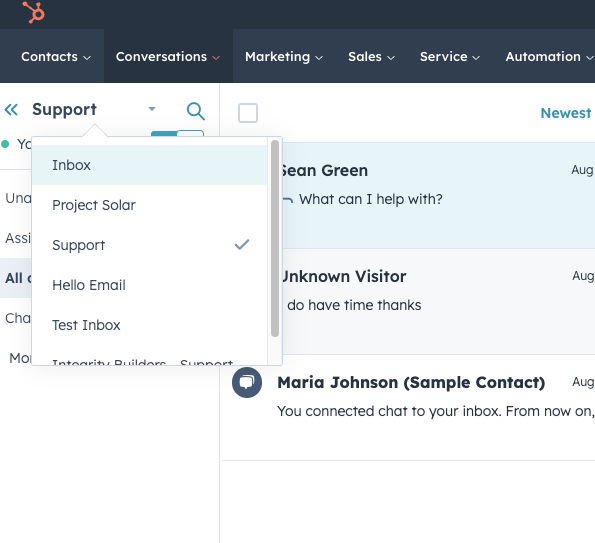
2: View Presets
On your left menu, you can see a list of preset views (Unassigned, assigned to me, all open, chat, etc.) to help you quickly find the types of conversations you’re most interested in at the moment.
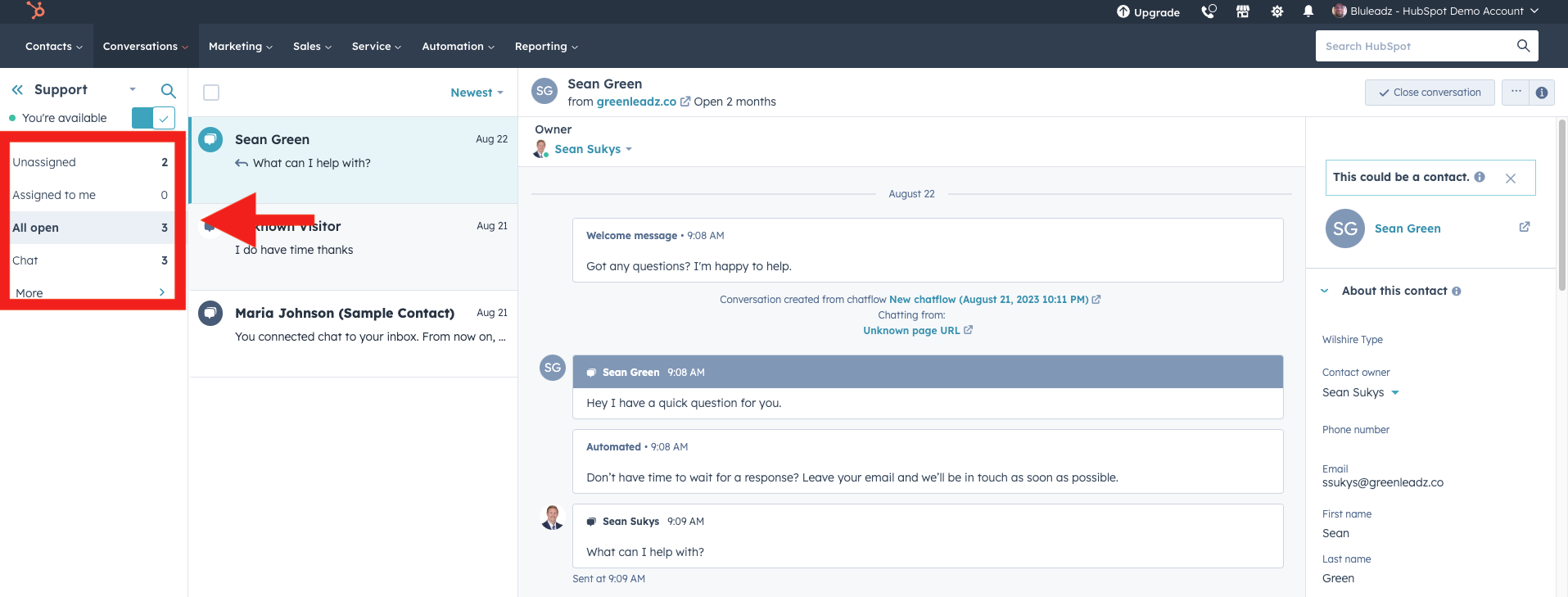
3: Search Function
In addition to the quick filters, you can access a search feature to help you find a specific conversation thread. Click on the magnifying glass icon in the left menu nav to get started. From there, you can enter a search term and apply additional filters to further narrow down your search.
Here’s a quick video showing the process:
4: Conversation List
In the second column from the left, you can find the list of conversations. Here, you’ll see a list of cards detailing information such as:
- The contact’s name
- A forward/reply indicator (helping you identify which threads you need to reply to)
- A preview of the email subject line (if applicable)
- A channel icon
- The preview of the most recent communication
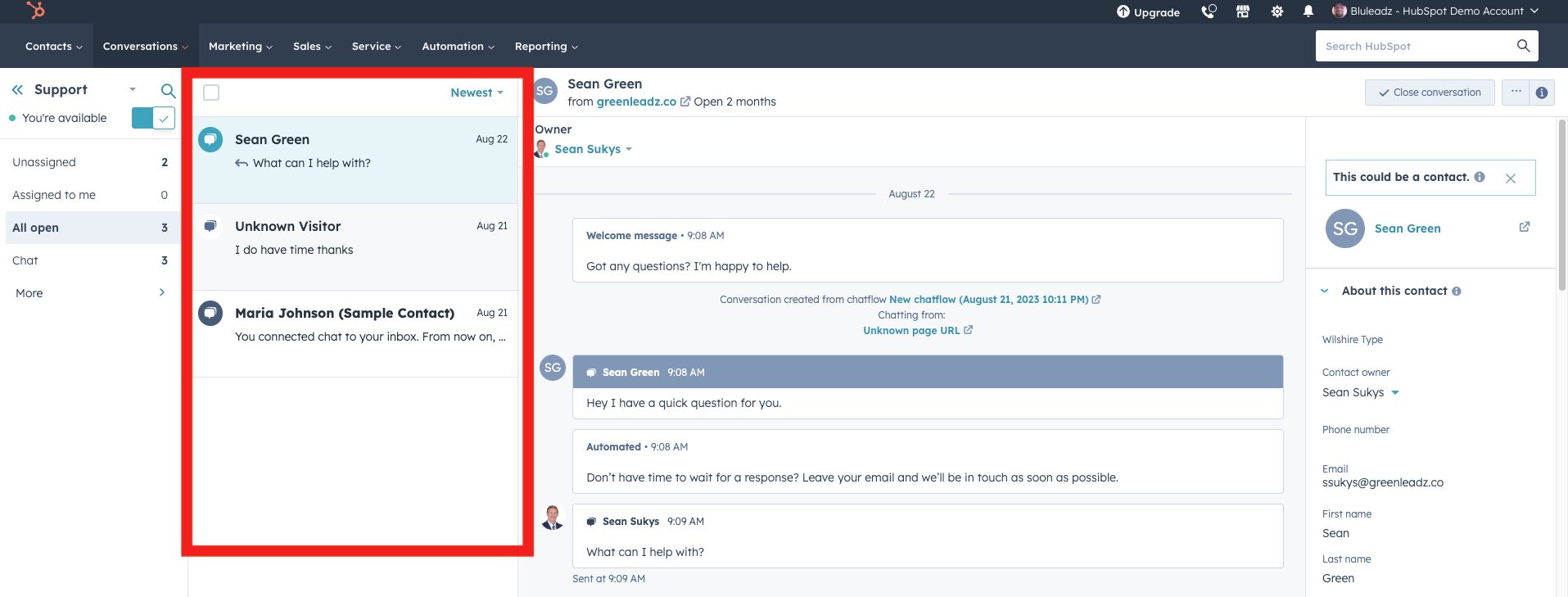 5: Contact Information
5: Contact Information
When you click on a conversation from the list, the column on the far right will show details about that contact, such as who their contact owner is, their email, phone number, and other contact details, what companies they’re associated with in your HubSpot database, other conversations they’ve been part of, tickets involving them, and more.
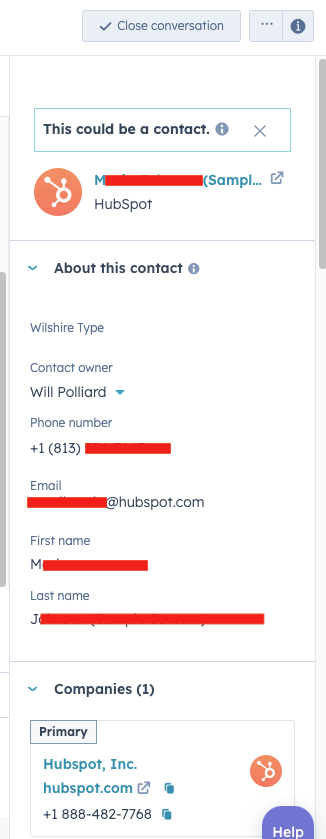
6: Reply/Comment Column
The largest section of the conversations page is the column showing the most recent messages. Here, you can reply and comment on the currently-selected message thread—here’s a quick video showing how to use this tool:
Odds are that this will be the column that most captures your attention when you hit the conversations inbox page. It’s the biggest column and it gives you the immediate ability to reply to your prospects.
If you want to make sure that a specific person sees your comments on a conversation, you can click on “comment” and then put in an at mention—where you type the “@” symbol and follow it with the other person’s name.
For example, if I was in the tool and saw a hot lead owned by John Smith and John hadn’t followed up with them in a couple of days, I might put a comment in the thread saying something like: “Hi @JohnSmith, have you followed up with [contact.name] here? Please do so once you can or let me know if there’s a reason we shouldn’t follow up with this lead.”
Which Tier of HubSpot Unlocks the Conversations Inbox?
Now that we’ve gone over some of the key features in the conversations inbox, how do you get access to it?
Let’s start with the good news: If you have any tier of HubSpot subscription, you have access to the HubSpot Conversations tool.
However, your subscription, whether you have a “paid seat,” and the access privileges set for your account by your system administrator in your HubSpot portal may affect which features will be available to you.
For example, a “free tools” subscription is limited to one inbox. You cannot set up multiple inboxes on the free account to accommodate the needs of different teams—everyone will have to share.
Marketing Hub Starter, Sales Hub Starter, Service Hub Starter, and CMS Hub Starter are all also limited to one inbox. The Professional tiers of these subscriptions allow you to have 100 inboxes. Finally, the Enterprise versions of these Hubs allow you to have up to 200 inboxes.
If you do not have a paid sales or service hub seat, then conversations cannot be automatically assigned to you. However, free users can still assign and respond to unassigned conversations if they have inbox tool access.
So, How Much Does the Shared Inbox Tool Cost?
Technically speaking, the conversations inbox tool is free. It’s available on the free tools subscription. However, to have access to more than one inbox (so you can create custom inboxes for each of your teams), you’ll need to have a paid subscription to at least one of the Marketing, Sales, Service, or CMS Hub accounts at the Professional or Enterprise tiers.
- Marketing Hub pricing starts at $890/month (with added onboarding fees for new users) for a Professional subscription—and $3,600/month for an Enterprise subscription (also with additional onboarding costs). However, Marketing Hub does not come with Sales and Service seats—this would require a separate Service or Sales subscription.
- Sales Hub pricing starts at $500/month with 5 users included—meaning you get to have five paid seats for tools like the conversations inbox. Sales Hub Enterprise starts at $1,200/month and comes with 10 users.
- Service Hub pricing is identical to the Sales Hub pricing: $500/month for a Professional subscription with 5 user seats or $1,200/month for an Enterprise subscription with 10 user seats included.
- CMS Hub costs $400/month for the Professional Tier account and $1,200/month for the Enterprise subscription, but does not come with user seats.
How Do I Get Additional Seats?
Wondering how you can get paid seats for the HubSpot subscriptions that don’t include them (or if you’ve hit your seat limit already and need more)?
One way to add a couple of seats is to sign up for a Sales Hub or Service Hub Starter account. Sales Hub Starter is $20/month (billed annually) and comes with two sales seats, while Service Hub Starter is also $20/month (billed annually) and comes with two service seats. With both, that’s up to four paid users.
Or, you can request a paid users add-on to your account for $200/month that add 500 paid seats to your account—ideal for larger organizations that have hundreds of sales reps who need access to HubSpot’s CRM tools to consistently hit their sales goals.
What’s the Best Way to Get Started with the Inbox Tool?
Okay, you have your HubSpot subscription, a paid service or sales seat in your HubSpot account, and conversation permissions from your account administrator. Now what?
Now it’s time to set up your inbox so you can put it to its best use!
Here are a couple of pointers to get you started:
Give Your Inbox an Appropriate Name
Whether you only have one inbox available on a starter account or if you plan on creating dozens of inboxes, you’ll want to give your inbox an appropriate name. This helps you more clearly define what you (and your team) should be doing with the inbox.
For example, if you’re planning to use the conversations inbox for sales conversations with prospects who are on the cusp of becoming customers, you might want to name the inbox “Closing Conversations” or “Sales.” If you were using the inbox to provide customer support, you might name it “Support.”
If you have an especially big client and a Professional or Enterprise-tier HubSpot subscription, you might even give the inbox the name of that client and use it for all conversations with that account.
Consider Which Communication Channels You Need to Connect to Your Inbox
How are customers communicating with you? Are they using a chatbot on your site? Sending you messages on Facebook Messenger? Emailing your (or your company’s) email inbox? Make sure all of these channels are connected to the inbox you’re setting up!
Although not every channel needs to be part of every conversations inbox, the ones that your prospects use to reach out for specific types of communications really should. For example, if you’re making an inbox for support tickets, you’ll want to include the channels that your customers frequently use to submit support requests—such as your company’s email, chat channels, or form channel.
Meanwhile, an inbox focused mostly on marketing conversations earlier in the sales funnel might want to include social media messages in addition to emails, chat responses, and form fills.
Whenever you’re setting up a new inbox, start with how you expect your customers to reach out to you. Think about the goal of the inbox, what your customers want, and how they typically reach out for different kinds of conversations, then add the appropriate channels to your inbox.
What Does Connecting an Email Inbox to HubSpot Do?
So, what does “connecting” an email inbox to your HubSpot conversations tool do, exactly? Here’s how HubSpot explains it:
“After you connect your inbox, any replies to emails that you sent from the CRM, or from your mail client using the HubSpot sales email extension, will then automatically log in your CRM. You can also track any email sent from your CRM in your connected inbox's Sent folder (Google Apps, Gmail, and Office 365 inboxes only).”
Here’s what connecting different channels to your conversations inbox can help you accomplish:
- Your Team Email. This allows emails sent to a shared team address to appear in your conversations inbox. You can also change the "from" name and address of emails, edit the team signature, and choose who team emails are routed to.
- Chat Channels. This allows you to add chatflows to your website pages.
- Facebook Messenger. This allows you to add chatflows to your Facebook Business page. Also, any messages sent to your business on Facebook will appear in your inbox.
- Forms. Connecting forms to your conversations inbox will allow you to see submissions from your conversations tab as they happen. Additionally, you can generate tickets based on your form submissions. This helps to simplify follow-up for key form submissions.
- WhatsApp Business Account. Available for Marketing Hub or Service Hub Professional and Enterprise subscriptions only. This connection allows you to send and receive messages from a verified WhatsApp phone number.
How Do I Set Up an Inbox Connection?
The process for connecting channels to your inbox may vary slightly depending on the channel in question. Here are some quick tutorials on connecting different channels to your conversations inbox:
Connecting a Team Email Channel
- Click on the gear icon in the upper right of your HubSpot nav menu.
- In the left sidebar menu, scroll down to Inbox under the “Tools” heading and click on the dropdown.
- Click on Inboxes.
- Choose the inbox you want to add a channel to from the dropdown next to the “Current view” header.
- Click on “Connect a channel.”
- Click on “Team email.”
- Pick the type of email account you’re adding.
- Follow the onscreen instructions for connecting the inbox. You will be asked to verify that you want to connect your inbox and be presented with a privacy notice.
- Review the terms for sharing the email with HubSpot and click “Continue.”
- Select or type in the email address you wish to connect.
- Customize the email details when the screen pops up. You can set a custom signature, set who the email is from when sending through conversations, and the company name.
- If you have a paid seat in the Sales Hub or Service Hub, you can also set routing rules to choose who gets incoming emails being sent to that address.
- You can also toggle whether to create tickets based on emails to the chosen address.
- Review your settings, and click on “Save” if you’re satisfied with them.
Here’s a two-minute video showing how to do it:
Connecting a Chat Channel to Conversations
Connecting a chat channel to your conversations inbox is easy-peasy. From the “Connect a channel” step listed above:
- Select the “Chat” option from the pop-up menu. Note: the chat widget will default to your account’s brand settings in HubSpot, but you can manually change it if you want using a hexadecimal code or the color selection tool in HS.
- Click on “Next.”
- Click on the “Chat Heading” dropdown menu and customize the options you’re presented with:
- Which users and teams appear at the top of the chat widget.
- Chat display name.
- Contact owner.
- Add a custom welcome message in the text box. This will be the first thing a visitor sees when the chatbot opens up.
- If you’re on Sales Hub or Service Hub and have a paid seat, you can set assignment rules to route incoming chats to your team members. Click on the “Automatically assign conversations” toggle and then click the “assign to” dropdown menu and choose from one of the following options:
- Specific users and teams
- Contact owner
- You can also set custom “away” messages for when it’s off-hours or the chosen user or contact owner is unavailable. This can be based on specific days of the week, specific times of day, or the contact owner/user being logged in.
- Review your new chat widget using the device type buttons above the preview to see how it will appear on different devices.
- Once you’re satisfied with the widget, click on “Publish.”
Here’s a quick video showing the process:
Don’t worry, you can always edit your connected chat widget from the inbox settings menu at a future date if you want to make changes!
Connecting a Facebook Messenger Channel
First rule about connecting Facebook Messenger to your conversations inbox: have a dedicated Facebook Messenger work or company profile to add. You may not want to connect your personal account to your work-related HubSpot. Otherwise, you’ll be inundated with personal messages on your conversations tool!
Also, you’ll need to be an admin on the Facebook page you wish to connect, so that’s another requirement to check prior to connecting this channel to your conversations inbox. You cannot connect a Facebook Messenger account to more than one HubSpot Account.
Here’s the process:
- From your inbox management tab in your HubSpot profile, click on “Connect a channel.”

- Select “Facebook Messenger” from the pop-up menu.

- Click on Continue with Facebook.
- You will be shown a pop-up at this point—pop-ups must be enabled in your browser for this step to work.
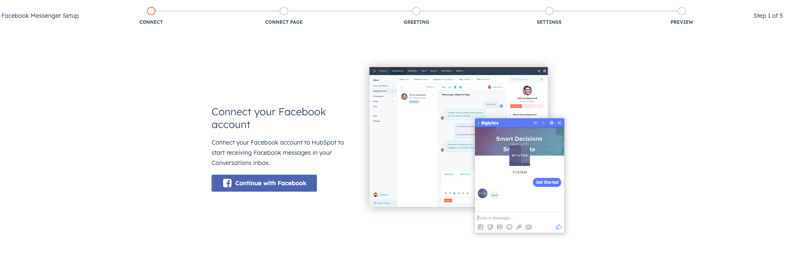
- Log into your Facebook account.
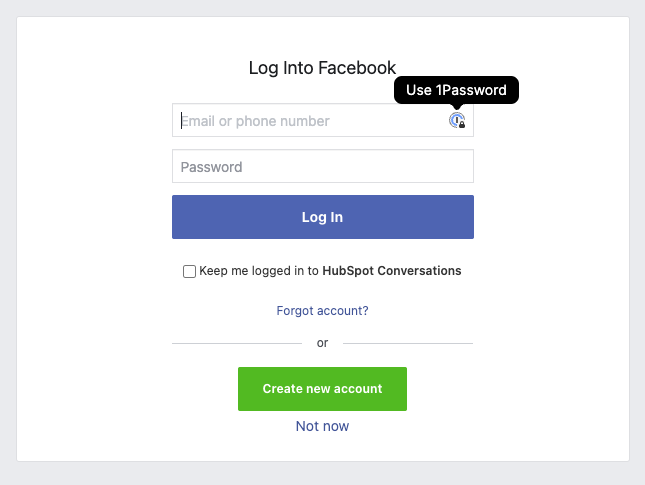
- Click on the page you wish to connect.
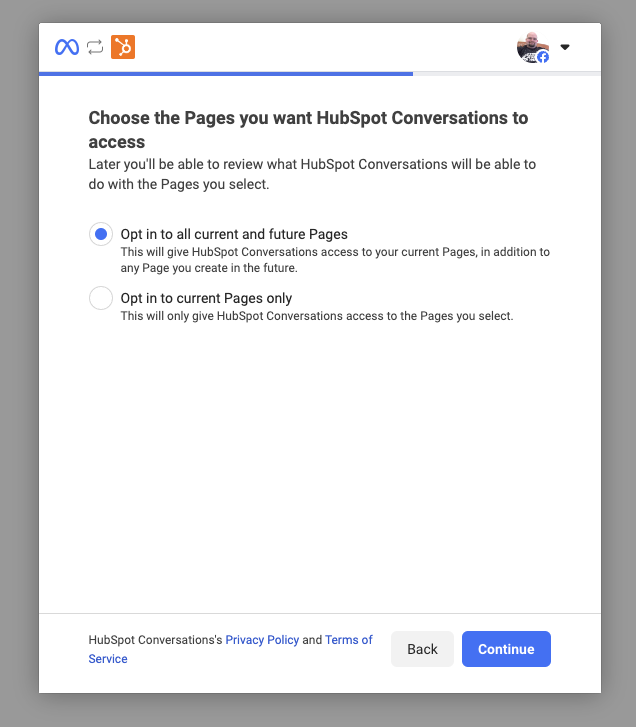
- If you don’t currently have a page, you will be given the opportunity to create one here.
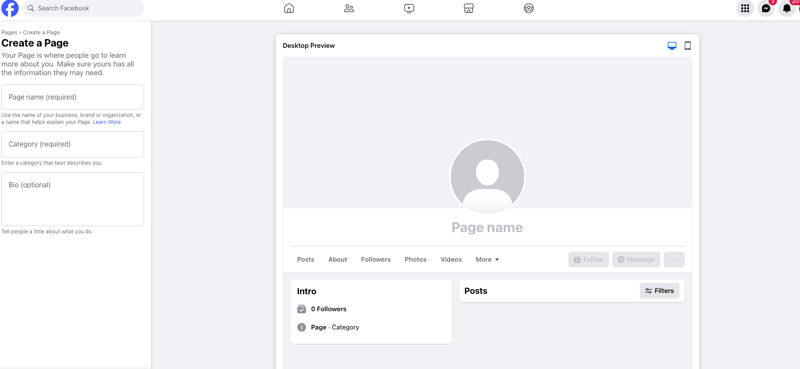
- Start customizing your greeting that will display when a visitor starts a conversation with you on Facebook.
- Click “Next.”
- If you want, use the “Send instant reply” text box to generate a reply for immediately after a visitor sends their first message.
- If you have a Sales Hub or Service Hub paid seat, you can set routing rules for Facebook Messenger messages to choose who on your team receives incoming messages. By default, these messages are unassigned.
- Like with the chat feature, your options can be either specific users/teams or the contact owner.
- Once you’re done customizing messages and setting routing for FB Messenger messages, click “Next.”
- Preview your Greeting and Instant Reply messages using the buttons above the preview image.
- Click “Done” in the bottom right.
Connecting and Customizing a Form Channel
Connecting a HubSpot form to your conversations inbox is pretty straightforward.
- From your inboxes menu, click on “Connect a channel.”
- Select “Forms.”
- From here, you can either select an existing form from the dropdown menu or set up a new one.
- If creating a new form, click on “Create new form” and follow the onscreen prompts to set up your fields and options.
- Once you’re done customizing your form, click “Next.”
- If you have a Sales Hub or Service Hub paid seat, you can assign incoming form submissions to specific users in your portal.
- Click the “Automatically assign conversations” toggle to turn this feature on or off.
- Click on the “Assign to” dropdown and choose either specific users and teams or the contact owner.
Here’s a quick video walkthrough showing the process:
Connecting a WhatsApp Business Account Channel
If you’re on Marketing Hub or Service Hub at a Professional or Enterprise level, you can also connect a WhatsApp Business account to send and receive messages from a verified WhatsApp phone number.
Here’s the process:
- From your Inboxes settings menu, click on “Connect a Channel.”
- Select "WhatsApp” from the pop-up menu.
- Click on the “Continue with WhatsApp” option.
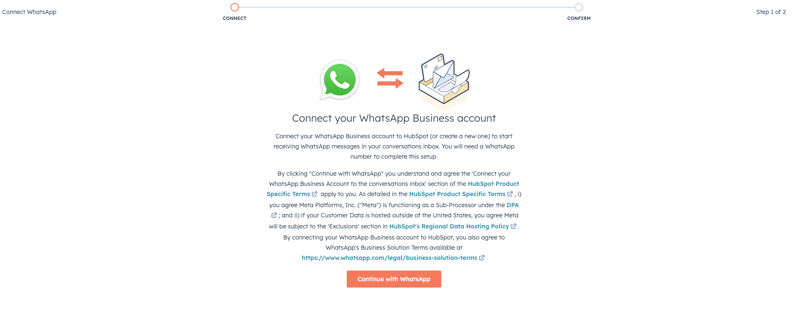
- You’ll be asked to log into your Facebook account for your WhatsApp Business profile.
- Follow the onscreen prompts to either select an existing WhatsApp Business profile associated with your Facebook account or create a new WhatsApp Business page if necessary.
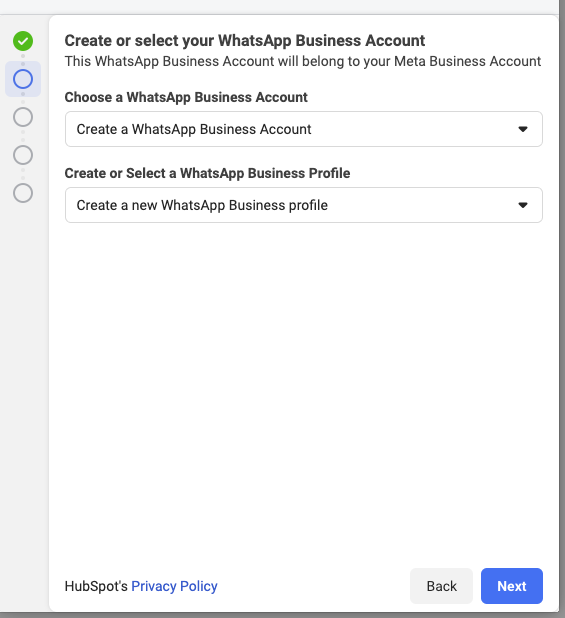
- When finished, click “Continue.”
- On the confirmation screen, click on “Connect”
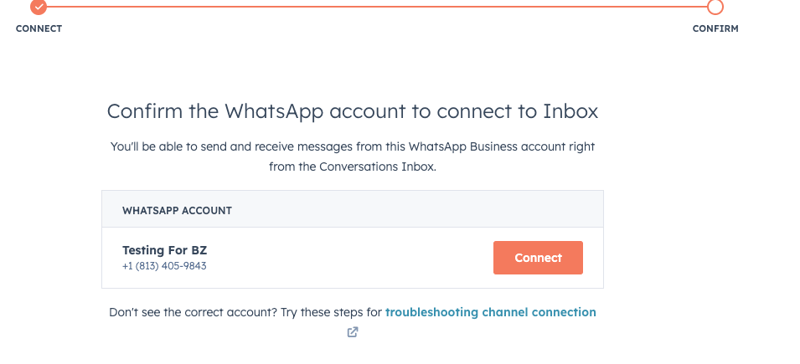 How Do I Manage Inbox Users on My Team?
How Do I Manage Inbox Users on My Team?
So, how can you control who is able to access your conversation inboxes in your HubSpot portal? You can do this by managing their paid seat settings from the Users and Teams menu.
If you’re a super admin in your HubSpot portal, simply:
- Click on the “Actions” button for the user whose permissions you want to edit.
- Click on “Edit permissions” from the dropdown menu.
- Click on the “Narrow access with permissions” option.
- In the dropdown, either add or remove the user’s paid seat access as needed.
By taking away the user’s paid seat access, you can limit their ability to access the conversations inbox tool.
You can also control who can edit an inbox from inside the inbox settings’ “Access” tab. Here’s a quick video showing how you can do this:
How Do I Manage Tickets with the HubSpot Inbox?
One of the key features of the conversations tool is the ability to create tickets in HubSpot based on the communications you receive across all of the channels connected to that inbox. But, how can you manage tickets in the HubSpot conversations inbox?
Here’s a quick tutorial to help get started:
- In your HubSpot menu navigation, click on “Conversations” then click on the “Inbox” option from the dropdown.
- Click on a conversation from the left panel to open it.
- In the right sidebar, click on the “Ticket” dropdown menu to expand an existing ticket or “Create a ticket” to start a new one.
- From here, you can edit ticket properties or view additional ticket information.
- To edit ticket properties, click the property and enter a new value for it.
- To view additional information about the ticket, click on “View more.”
- In the panel that opens on the right, click Edit the shown properties to customize which properties are displayed in the ticket details panel.
- You can reply to the contact from the reply editor at the bottom of the screen, if needed to help resolve the ticket.
- You can also access the ticket record by clicking on the ticket name at the top of the conversation.
Here’s a quick video tutorial to help visualize this process:
How Do I Compose or Reply to Emails from the HubSpot Inbox Tool?
Composing an email or replying to one in the conversations inbox is incredibly simple. To reply to a message, just click on the conversation you want to reply to and write your message in the field at the bottom of the screen!
You can also compose emails in the conversations inbox by clicking on the “Compose” button in the bottom-left of the inbox screen to start a new conversation.
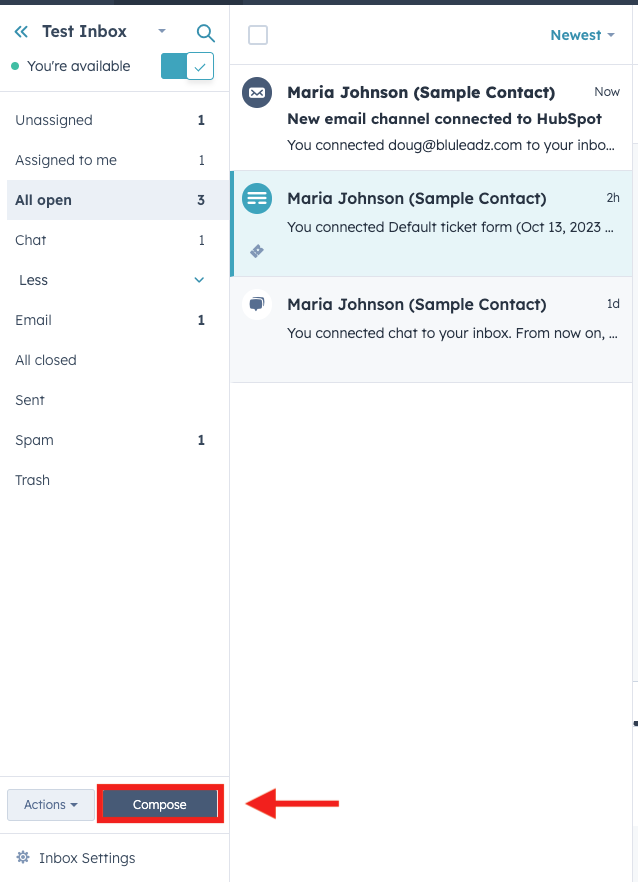
Note: To compose emails in the conversations inbox, your email address has to be connected as a channel in that inbox. If your email isn’t connected to that specific inbox, the “compose” button won’t appear.
How Do I Create Contacts from My HubSpot Inbox?
Creating contacts is a core feature of the HubSpot platform. Typically, you would do this by having a visitor fill out a HubSpot form on your website. However, you can also create contacts from inside of the HubSpot Conversations tool.
How? There are a few methods to do this:
Method 1: Manually Creating the Contact
You can do this by asking for the visitors contact information during a chat session and creating the contact manually in your HubSpot portal. Inside of the inbox tool:
- Click on the chat conversation for the visitor you want to add as a contact.
- In the right panel, click on “Associate visitor.”
- When the dialog box pops up, enter the visitor’s email address. If a contact is found in your database, you can associate the chat with that existing contact. If there isn’t a match, you’ll be prompted to create a new contact.
Method 2: Email Capture
You can also set your chatflows to capture visitor emails to automate the process of collecting email information. Here’s how:
- Go to “Chatflows” under the Conversations menu option in your HubSpot nav menu.
- Hover over the chatflow you want to customize and click “Edit.”
- On the Build tab, click the “Ask visitors for their email address” dropdown menu and pick from the following options:
- Immediately after the first message is sent.
- If no team member responds after a minute.
- Do not ask for email address.
- Then, enter your custom message in the email capture field message. Try to customize the message to conform with your chosen request timing.
- Click “Save.”
Method 3: Automatically on Receiving an Email to a Connected Email Inbox
If someone sends an email to a team inbox connected to your HubSpot account a new contact can be automatically created based on that email. The contact record can then be progressively filled out as they fill out forms or give you information in your conversations with them.
If the email is already associated with an existing contact in your database, the conversation will be added to their contact record.
How Do I Delete a HubSpot Conversations Inbox?
So, you want to delete your conversations inbox. Whether you need to make room for a new inbox or the old one has simply become obsolete and you don’t want it taking up space in your portal, it’s fairly easy to remove a conversations inbox.
Here’s the process:
- Go to Settings (the gear icon in the top-right of your HubSpot portal.
- Click on Inbox under the Tools menu on the left.
- Click on Inboxes.
- Click on the dropdown menu next to the “Current view” prompt and select the inbox you wish to delete.
- Click on the “Actions” button.
- In the dropdown menu, click on “Delete inbox.”
- You’ll be given a pop-up prompt verifying that you want to delete the inbox and if you want to delete the channels, chatflows, and conversations associated with that inbox. To delete the inbox, the channels and chatflows MUST be deleted, but you can opt out of deleting the conversation threads.
Here’s a quick video showing the process:
In the video, you can see how the delete option doesn’t light up until both the channels and chatflows are marked for deletion. This serves two purposes:
First, it helps prevent accidental deletions since you need to check two separate boxes to delete an inbox.
Second, it serves as a reminder that you will be losing access to those channels and chatflows.
How Do I Manage My Chat Availability for HubSpot Inbox?
Okay, so you’ve created an inbox and connected some team emails and live chats to it. How do you make sure that you aren’t sending annoying message pings to Jim from marketing at 2:00 am when he’s trying to sleep? How do you ensure that conversations aren’t being assigned to team members when they’re on vacation and can’t respond?
There are a couple of ways to handle availability for your chat inboxes.
Method 1: Manually Setting Availability
One is from the Availability Management menu. Here, you can manually set an individual employee’s status to either “Available” or “Away” as needed.
You can find this tool in your HubSpot settings menu (the gear icon in the upper right of your HubSpot portal’s nav menu) in the “Inbox” dropdown under the “Tools” header in the left navigation panel.
From the availability management menu, you can see a list of all the users in your HubSpot portal and manually edit their settings. Just click on the dropdown in the “User Status” field to manually change their status to either “Available” or “Away.”
This is great for manually overriding someone’s availability if they go on vacation so you don’t need to edit their availability for every inbox they’re part of. It’s as simple as 1, 2, 3, 4!
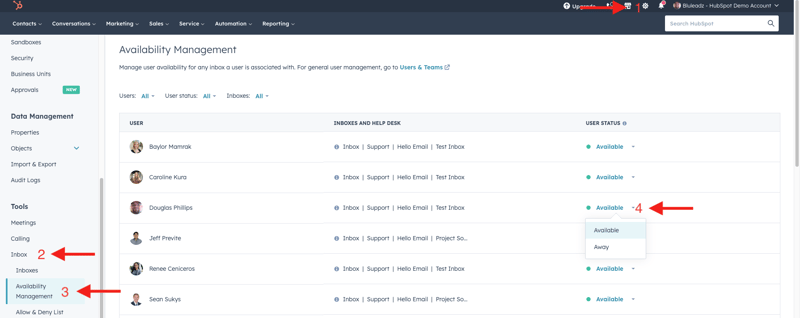
Method 2: Setting Available Hours for Users in the Chatflow
When setting up a chatflow for your inbox, you can edit the availability of the channel. You can also edit the already-assigned availability of the chatflow from the inbox tool. Just go to the inbox you want to edit the chatflow for, click on the “edit” button for that chatflow, and change the settings based on your preferences.
Here’s a quick video showing how:
You’ll notice that you can set the chatflow to be based on the availability of your team. In other words, as long as one member of your team is “available,” the chatflow will be active. Or, you can set it based on specific days of the week and times during the day.
You can even set specific messages for display when an agent is unavailable or cannot respond within your typical SLA period.
Speaking of service level agreements…
How Do I Set SLAs in the HubSpot Inbox?
Okay, you’ve created an inbox, how do you ensure that your team responds to messages or closes tickets made through the conversations tool in a timely manner? That’s where the SLAs tab of your inbox management tool can help!
It’s easy to create SLAs in the HubSpot conversations tool:
- Start by navigating to your inbox management menu from the HubSpot Settings menu—Settings > Tools > Inbox > Inboxes.
- If you have more than one inbox, click on the dropdown next to “Current view” and select the inbox you want to set SLAs for.
- Click on the SLAs tab. Here, you’ll be presented with a few toggles for ticket SLAs.
- Pick a method for applying SLAs, the menu defaults to “apply based on calendar hours.” The other option is to apply them based on working hours—there’s also an option to “manage your team’s working hours” below this dropdown—this defaults to Mon-Fri, 9:00 am to 5:00 pm.
- Choose whether to toggle on time to first reply SLAs. This is important if you want your team to reply quickly to messages and to control performance expectations.
- You can choose to apply this SLA to all tickets in the inbox or to apply different SLAs based on ticket priority—such as giving low-priority tickets a longer lead time while giving high-priority tickets a much shorter SLA.
- Choose whether to toggle on time-to-close SLAs.
- The settings for time-to-close are similar to the time to first reply SLAs. However, they do need to be longer than your time to first reply SLAs.
- Once you’ve completed your SLA settings, click “Save.”
Here’s a quick video showing the process:
Obviously, you’ll want to make sure that your SLAs are realistic for the type of work that would be involved with closing those tickets. Here, having dedicated conversation inboxes for specific types of interactions can be very useful for creating consistent and realistic SLA timelines. For example, it’s probably unrealistic to expect a complete overhaul/repair of a website page to fix numerous critical bugs to take the same amount of time as a ticket that can be resolved by sharing a quick troubleshooting tip over the phone or in an email.
How Do I Use Conversations on the HubSpot Mobile App?
So, you’re on the go and you want to keep an eye on your conversations inbox from your HubSpot portal. How can you do this? Well, this is where the HubSpot mobile app can help!
To use conversations on the HubSpot mobile app, simply:
- Open the app on your device.
- Log into the HubSpot account associated with the portal you wish to manage conversations for in the app.
- Tap the hamburger menu button.
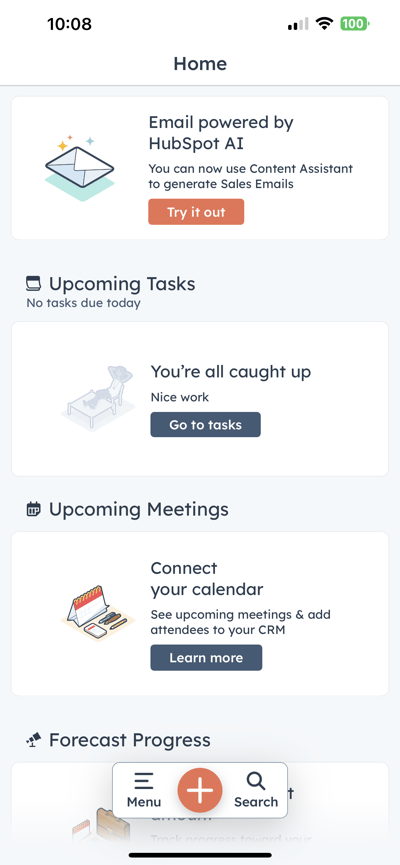
- Tap on the “Conversations” Button on the slide-in menu that appears.
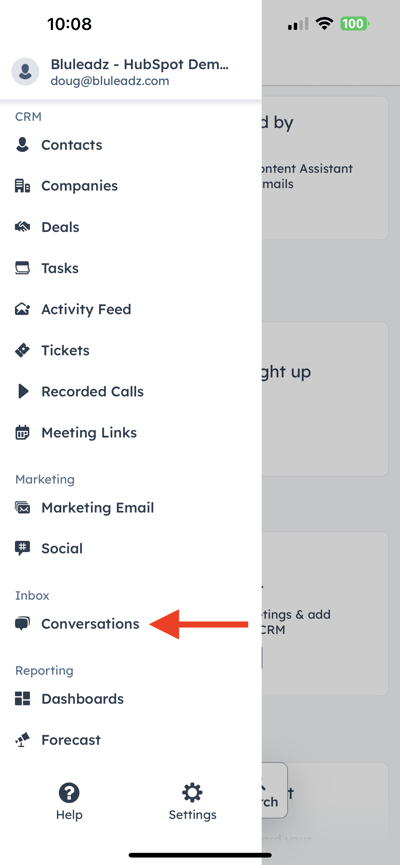
- If you have more than one inbox, tap the inbox name at the top of the screen and select the inbox you want to manage from the dropdown menu.
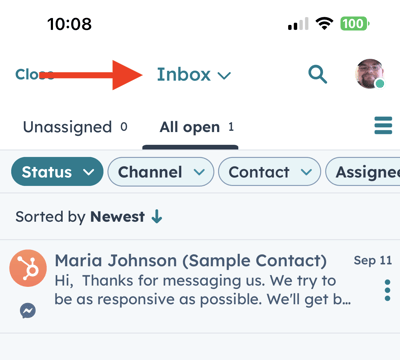
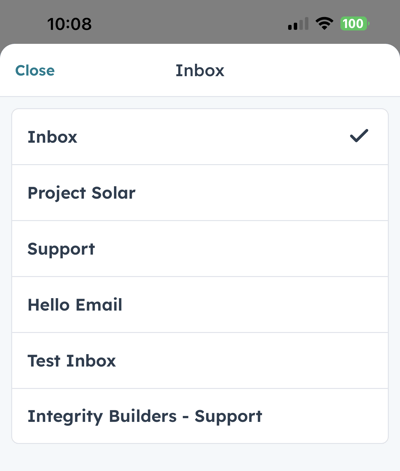
- You can change which conversations are displayed (Assigned to you, all open, unassigned, etc.) by tapping the hamburger menu below your picture and tapping on the view you want to see.
- If SLAs are enabled for the inbox, you’ll see labels appear in the message if the reply or ticket closure is overdue.
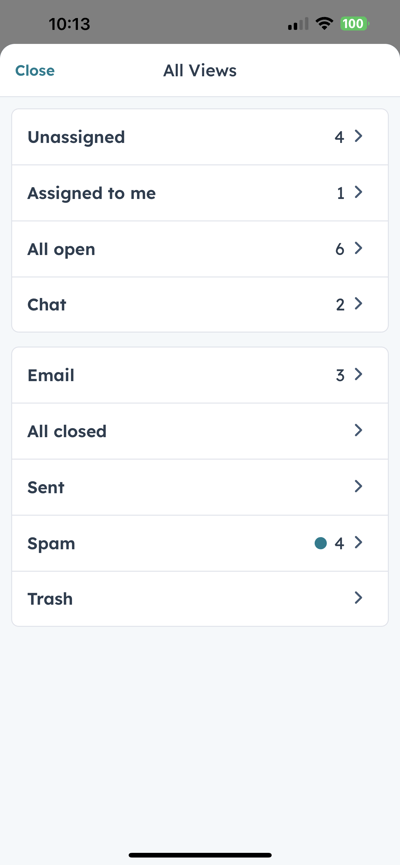
- Open a conversation by tapping on it. You can edit the contact record by tapping on the contact’s name from here.
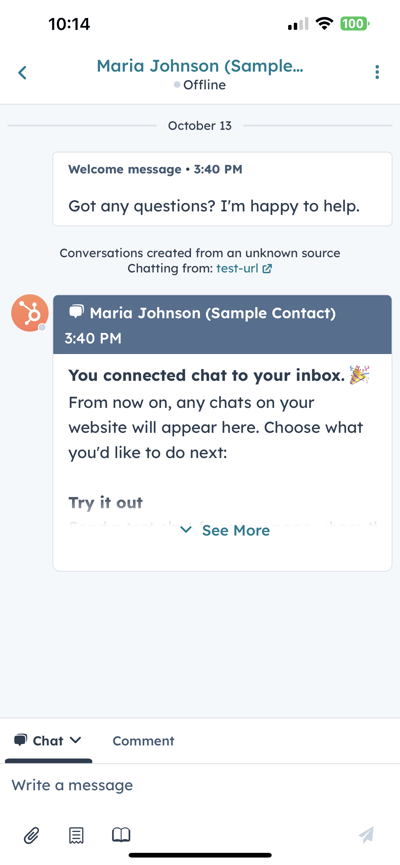
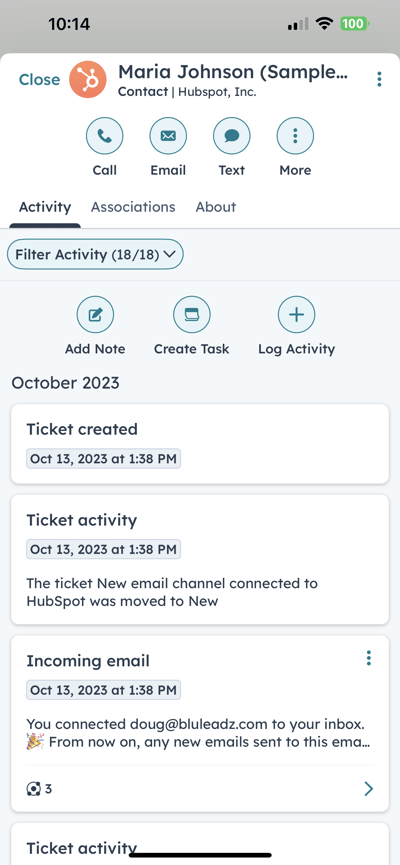 If the visitor in the conversation is unknown, you can tap the “+” icon and search for an existing contact to associate the conversation with.
If the visitor in the conversation is unknown, you can tap the “+” icon and search for an existing contact to associate the conversation with.

For the most part, using the mobile app for your inbox will be similar to how it works on your desktop, just with a different interface.
However, to actually edit the inbox or create a new inbox, you’ll need to use the regular HubSpot interface in your browser.
What Information From HubSpot Inbox Is Logged into the CRM?
So, what information does HubSpot log from the inbox into your CRM portal? Here’s the explanation from HubSpot:
“When you log an email to a contact record in the CRM or receive an email reply from them, the HubSpot CRM stores your contact’s email address, name, subject line, and body text so that the email can be displayed as part of their contact record in the CRM. The email is stored and displayed just as if you had BCC’d or forwarded that email to the CRM. Attachments sent outside of the CRM will be stored in the Attachments section in the contact record.”
HubSpot will only use the text of an email to display it in the contact record of the recipient and in the conversations tool. However, this data will be stored indefinitely unless your HubSpot account is deleted, so it’s important to practice good cybersecurity hygiene to protect your prospect’s data and privacy.
In other words, don’t share your passwords, change your passwords on a regular basis, and try not to download non-work apps and programs on the device you use to access your HubSpot portal—just to name a few good cybersecurity practices.
How Secure Are HubSpot Inboxes?
So, how secure are HubSpot inboxes? About as secure as they can be for any platform with human users.
HubSpot does work to minimize risk by using strong security measures such as data encryption for “data in flight” (data being transmitted from one point to another), defense-in-depth tools (i.e., using layers of security to minimize the risk of compromise and compartmentalizing any breaches that do occur), and threat intelligence solutions that help analyze how attackers work so future attacks can be blunted before they happen.
However, no amount of security can stop everything—especially if your user account is compromised because a password was shared to the wrong person or a compromised computer with keylogging software or other data mining tools was used to log into your HubSpot portal. Please help HubSpot protect your data by practicing strong cybersecurity within your own organization.
How Do I Create Different Inboxes or Views for Internal Departments?
Wondering how you can create different inboxes or inbox views for different teams in your organization? It’s easy.
To Create a New Inbox
To make a new inbox, simply go to your HubSpot settings menu, click on “inboxes” from the inbox dropdown under “Tools” in the left nav, and click on “Actions” in the upper right.
From there, you can click on “Create new inbox” to open a new inbox, choose a name, pick who can edit the new inbox, and start adding channels!
To Create a New View in an Existing Inbox
To make a new view for an inbox directly in the conversations tool. Here’s how:
- Click on “Conversations” in your HubSpot navigation menu and click on “Inbox.”
- Select the inbox you want to create a new view for.
- In the bottom left of the screen, find and click on the “Action” button.
- Click on “Create a view.” You’ll be prompted to name your new view—be as descriptive as possible with as short a name as possible to make it easy on future users!
- In the Filter type section, pick the filter option. Types of filters you can create include default ticket properties, conversation properties, and custom ticket properties that you’ve created in your HubSpot portal.
- Once you’re done, click “Next.”
- Search for the property you want to filter conversations by, then select the criteria for that filter property. This bit may be familiar to users of the HubSpot Workflows tool.
- You can further refine your filter criteria using the AND/OR logic tool.
- When finished, click “Create View.” It may take a minute or two for the portal to complete the view.
- Congratulations! You’ve created a new filter view for your team to use!
In this example, I created a custom view for myself based on open tickets. This way, whenever I open this inbox and use this view, I can quickly see which tickets are open.
How Do I Route HubSpot Inbox Conversations to the Right Users or Teams?
In addition to automatically routing conversations to users during the setup process for different channels in your HubSpot inboxes, you can manually route conversations in HubSpot to specific users.
The first step is ensuring that the person you want to assign the conversation to has access to the inbox. Once you’ve confirmed that, it’s as easy as:
- Clicking on an unassigned conversation or one that you own in the inbox.
- Clicking on the “Owner” dropdown menu and selecting who you want to assign the conversation to.
Here’s a quick video tutorial:
Can More Than One User View an Inbox Conversation?
Yes. More than one user can view an inbox conversation. In fact, you can see when another active user is responding to a conversation thread in HubSpot—their avatar will appear in the reply editor and a typing symbol will appear showing they’re in the middle of responding.
This lets you know to focus on a different conversation so you don’t waste time!
Essential HubSpot Inbox Resources
Want to learn more about HubSpot’s Conversations Inbox tool? Here are some links to their resources on the topic:
Reference Links:
- HubSpot Academy
- HubSpot Knowledge Base: Inbox
- HubSpot Community: Conversations Inbox
Goodbye, for Now
Well, that was a LONG one. It’s a lot to take in, I know. But hopefully, you’ll find this info useful. If you have any other questions about the conversations tool or need help optimizing it, reach out to the pros here at Bluleadz. We’ll be happy to help you out.



Douglas Phillips
Former military brat, graduated from Leilehua High School in Wahiawa, Hawaii in 2001. After earning my Bachelor's in English/Professional Writing, took on a job as a writer here at Bluleadz.